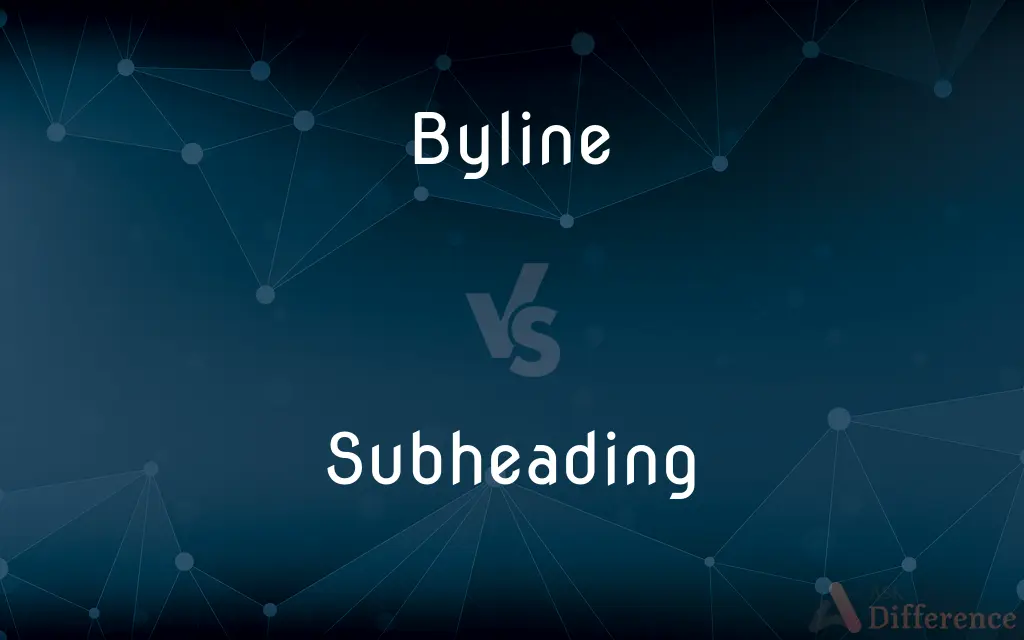Byline vs. Subheading — What's the Difference?
By Maham Liaqat & Fiza Rafique — Updated on April 1, 2024
A byline identifies the author of an article, while a subheading provides additional information under the main headline, breaking the content into sections.

Difference Between Byline and Subheading
Table of Contents
ADVERTISEMENT
Key Differences
A byline is a line in a newspaper, magazine, or online article that gives the name of the writer, offering credit for the work. It typically appears at the beginning or end of the piece, establishing authorship and sometimes including the writer's credentials or role. In contrast, a subheading is used within the article to divide it into smaller sections, making it easier for readers to navigate and understand the content. Subheadings summarize the following section's main idea, enhancing readability and organization.
Bylines serve to acknowledge the author's contribution, lending credibility and a personal touch to the article. They can help readers identify pieces by favored writers or experts in a specific field. Subheadings, on the other hand, act as guides within the article, helping to structure the narrative or argument in a logical way. They allow readers to skim the content effectively, picking out sections of interest without reading the entire piece.
The inclusion of a byline is crucial for transparency in journalism and publishing, as it ensures authors are accountable for their work. This can be particularly important in news articles, opinion pieces, and investigative journalism. Whereas the use of subheadings is more about enhancing the reader's experience, breaking down complex information into digestible parts and maintaining the reader's interest throughout the article.
Bylines can also provide insight into the level of expertise and perspective the author brings to the topic, indicating whether the piece is an opinion, editorial, or researched article. Subheadings, while primarily functional, can also convey the tone or perspective of the article, hinting at the writer's attitude towards the subject or the direction of their argument.
In terms of format, bylines are fairly standard across different types of publications, usually just consisting of the phrase "By [Author's Name]." Subheadings can vary widely in style, size, and placement, depending on the publication's design and the nature of the article. Creative and engaging subheadings can contribute significantly to an article's appeal, encouraging deeper engagement with the content.
ADVERTISEMENT
Comparison Chart
Definition
Line giving the name of the author.
A title or heading of a subsection within an article.
Purpose
Credits the author, lending credibility and accountability.
Organizes content, enhancing readability and navigation.
Location
Typically at the beginning or end of an article.
Throughout the article, dividing it into sections.
Contribution
Establishes authorship and expertise.
Summarizes sections, aiding in content comprehension.
Reader Benefit
Helps identify works by favored authors or experts.
Allows for efficient skimming and finding relevant information.
Compare with Definitions
Byline
Adds a level of personal touch and credibility.
Seeing a respected critic's byline on a review can influence readers' interest.
Subheading
Enhances reader engagement and comprehension.
Creative subheadings added a layer of interest, enticing readers to continue.
Byline
The line in an article that names the author.
The byline at the top of the article read By Jane Doe.
Subheading
To break down the article into manageable sections.
Subheadings made it easy to navigate the extensive research report.
Byline
Assists in tracking articles by specific authors.
Fans of the columnist always looked for her byline to read her latest insights.
Subheading
Scattered throughout, marking each new section.
Each subheading was bolded and slightly larger than the surrounding text for visibility.
Byline
Found at the beginning or conclusion of the piece.
The byline, positioned below the headline, immediately informed readers of the author's identity.
Subheading
Allows readers to quickly find information of interest.
She scanned the subheadings to find the section most relevant to her research.
Byline
To credit the writer and establish their authority on the subject.
The byline included the journalist's credentials, highlighting their expertise in political affairs.
Subheading
Titles or headings for subsections within the main article.
The article used witty subheadings to introduce each new topic.
Byline
The byline (or by-line in British English) on a newspaper or magazine article gives the name of the writer of the article. Bylines are commonly placed between the headline and the text of the article, although some magazines (notably Reader's Digest) place bylines at the bottom of the page to leave more room for graphical elements around the headline.
Subheading
A heading given to a subsection of a piece of writing
The page is broken up into short paragraphs with subheadings
This project falls under the subheading of ‘Skills and the Workforce’
Byline
A line in a newspaper naming the writer of an article
His byline appeared in the first issue
Subheading
See subhead.
Byline
(chiefly in soccer) the part of the goal line to either side of the goal.
Subheading
Any of the headings under which each of the main divisions of a subject may be subdivided
Byline
A line at the head of a newspaper or magazine article carrying the writer's name.
Subheading
A heading or caption subordinate to a main headline, heading, or title especially when inserted as a divider between sections (as of a newspaper or periodical article or story or text of a book)
Byline
To publish (a newspaper or magazine article) under a byline.
Subheading
A heading of a subdivision of a text
Byline
(journalism) A line at the head of a newspaper or magazine article carrying the writer's name.
Byline
(sports) A touchline.
Byline
To provide (an article) with a byline.
Common Curiosities
How can a byline benefit the reader?
A byline helps readers identify articles by their favorite authors or experts, enhancing trust and interest in the content.
What information can be found in a byline?
A byline typically contains the author's name, and it may also include their title, position, or a brief description of their expertise.
What is a byline?
A byline is a line in an article that provides the name of the author, establishing authorship and sometimes including additional information about the writer.
What purpose does a subheading serve?
Subheadings organize an article into sections, making it easier for readers to navigate through and understand the content by summarizing the main ideas of each part.
Do all articles use subheadings?
Not all articles use subheadings, especially shorter pieces or those in a narrative style, but they are common in longer, information-rich content.
Why are subheadings important in an article?
Subheadings are crucial for breaking down complex information, enhancing readability, and allowing readers to quickly find sections of interest.
Can a byline contain more than the author's name?
Yes, bylines can also include the author's credentials, role, or a brief bio, adding context and credibility to the article.
Is a byline always present in published works?
While most articles include a byline, some types of content, like editorial pieces from a publication's board, might not attribute a single author.
How do subheadings contribute to an article's design?
Subheadings contribute to the visual appeal and organization of an article, making the content more engaging and accessible to readers.
How do subheadings affect reader engagement?
Well-crafted subheadings can intrigue and guide readers through the article, encouraging them to read more thoroughly or focus on sections of interest.
Share Your Discovery

Previous Comparison
Bet vs. Wage
Next Comparison
Pincer vs. PincherAuthor Spotlight
Written by
Maham LiaqatCo-written by
Fiza RafiqueFiza Rafique is a skilled content writer at AskDifference.com, where she meticulously refines and enhances written pieces. Drawing from her vast editorial expertise, Fiza ensures clarity, accuracy, and precision in every article. Passionate about language, she continually seeks to elevate the quality of content for readers worldwide.















































